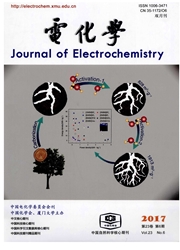

 中文摘要:
中文摘要:
通过熔融扩散法合成了一系列不同含硫量的有序介孔碳(CMK-3)/硫复合材料(C x Sy).使用X射线衍射(XRD)、拉曼光谱(Raman)、比表面积测定仪(BET)、扫描电镜(SEM)、透射电镜(TEM)分析、表征和观察样品.将复合材料组装成钠硫电池,室温下测试电化学性能.循环伏安(CV)曲线结果表明,室温钠硫电池在1.61 V处有一个还原峰,对应于Na2Sx(x=2-5)的形成;在1.82 V和1.95 V分别有一个氧化峰,对应于Na2Sx(x=2-5)的分解.50%(by mass,下同)硫含量(C1S1)电极0.05C(1C=558 mA·g^-1)倍率首周放电容量500 mAh·g^-1,50周期循环比容量为305.6 mAh·g^-1.交流阻抗数据拟合计算其表观活化能为21.83 kJ·mol-1.本研究可为室温钠硫电池多孔电极材料的研究提供一定的指导作用.
 英文摘要:
英文摘要:
A series of ordered mesoporous carbon(CMK-3)/sulfur composite(C x Sy) with different sulfur contents were synthesized via a melt-diffusion method. XRD, Raman, BET, SEM, and TEM techniques were used to characterize the structure and morphology of the as-prepared composite. The electrochemical performance of CMK-3/sulfur composite as the electrode of Na/S battery was tested at room temperature. Cyclic voltammograms show that one obvious reduction peak was located at about 1.61V, which is corresponding to the formation of Na2 Sx(x = 2 - 5), while two oxidation peaks were displayed at about 1.82 V and 1.95 V, which are belonging to the decomposition of Na2 Sx(x = 2 - 5). When the sulfur content in CMK-3/sulfur composite was 50%(by mass, C1 S1), the discharge capacity reached 500 mAh·g^-1under 0.05C(1C = 558 mAh·g^-1) rate in the first cycle and the capacity became 305.6 mAh·g^-1after 50 cycles. From the result of EIS tested at about 1.6 V under different temperatures, the activation energy was calculated to be 21.83 kJ·mol-1. This result provides the basis for further study of porous electrode materials for room-temperature Na/S battery.
 同期刊论文项目
同期刊论文项目
 同项目期刊论文
同项目期刊论文
 期刊信息
期刊信息
